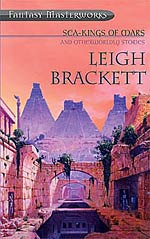
![]() Rhondak101
Rhondak101
2/13/2014
![]()
This collection contains the best of Brackett's planetary romances that were published in such pulps as Astounding Science Fiction, Planet Stories, and Thrilling Wonder Stories. They are:
The Sorcerer of Rhiannon (novelette, 1942)
The Jewel of Bas (novelette, 1944)
Terror Out of Space (short story, 1944)
Lorelei of the Red Mist with Ray Bradbury (novella, 1946)
The Moon that Vanished (novelette, 1948)
Sea Kings of Mars (aka The Sword of Rhiannon) (novella, 1949)
Queen of the Martian Catacombs (novella, 1949)
Enchantress of Venus (novella, 1949)
Black Amazon of Mars (novelette, 1951)
The Last Days of Shandakor (novelette, 1952)
The Tweener (short story, 1955)
The Road to Sinharat (novelette, 1963)
As planetary romances, they focus on such things as the big vistas of Mars, the gloomy atmosphere of Venus, cities made of ice, lost civilizations and relics, deathless, imprisoned gods, sea battles, sword fights, "manly" men and "womanly" women.
The chronological order of these pieces allows the reader to experience the development of Brackett's most famous character, Eric John Stark. Stark is an Earthman, born on Mercury. When his parents, miners on Mercury, die in a cave in, a Mercurian tribe adopts him. They call him N'Chaka, the man without a tribe. He lives with them, as one of them, until other humans from Earth arrive and kill the Mercurians. They keep Stark in a cage, like a pet or a circus oddity until more humans arrive and free him. One of this last group of humans, Simon Ashton, adopts Stark and civilizes him. All of this proceeding information is backstory, which leaks out through the various pieces Brackett writes.
Stark first appears in Queen of the Martian Catacombs (1949) as a fugitive, running from a prison sentence for gun-running. As we meet Stark throughout his other adventures, we learn that he is mercenary anti-hero, always on the wrong side of the law, but treating those he meets with honor. He saves lives and fights injustice. The other works about Stark that appear in this collection are Enchantress of Venus and Black Amazon of Mars.
Yet before the readers of this collection ever meet Stark, they meet his predecessors, who are very similar. Brackett's heroes are always tough, n'er-do-wells, on the wrong side of the law. They kiss a lot of women, including the virginal hero-worshippers who want to help them and the tough-as-nails, evil queens who want to kill them. Sometimes Brackett's heroes even get the girl, sometimes the good one, but often the bad one, who really wasn't so bad after all.
The protagonists of two of these pre-Stark pieces, The Sorcerer of Rhiannon and The Sea-Kings of Mars, are archeologists. The description of Max Brandon in The Sorcerer of Rhiannon provides a good starting place to analyze Brackett's rogues: "He was lionized as a dashing explorer, publicly cursed and secretly patronized by scientific men, the darling of wealthy collectors—all because of the archaeological treasures that he stole from under the noses of planetary governments. All this gave him money and fame and adoring fans, mostly feminine. It gave him the continual heady experience of dancing on the edge of disaster." Two of her later works also figure similar archeologists, The Last Days of Shandakor and The Road to Sinhart. (I would feel as if I was missing a really good opportunity if I did not mention that all of these macho grave robbers on Mars might be important precursors to Indiana Jones. After all, George Lucas, the creator of Jones, did hire Leigh Brackett to write the script for The Empire Strikes Back. It would be hard to believe that he did not know of her previous work. For more about this connection, see the review I wrote for Brackett's The Ginger Star.)
The two strongest pieces in the collection are The Sea Kings of Mars and The Road to Sinharat. The Sea King's plot is more developed than most of the other novellas and novelettes in the collection. The archaeologist Matt Carse is a smart and likeable. His relationship with Baghaz Hoi, a fat Valkisian felon, reminds me very much of Indy's relationship with Sallah. The Road to Sinharat is the last in the collection and, as such, was written in 1963, more than years after the first piece. Brackett's writing and plot are so much tighter after twenty years' of practice. Also, she's beginning to include "issues" in her plot. The Earthman archaeologist, Dr. Carey, is a fugitive because he speaks out against terraforming (although she never uses the word), while his Earth-based employers have a grand plan to change the surface of Mars.
The weakest pieces in this collection are the two short stories, "Terror Out of Space" and "The Tweener," neither seems to fit the themes of the other longer works. I recommend this collection. If you are in the mood for some planetary romance, give Leigh Brackett a chance. Her work rivals masters of the genre, like Edgar Rice Burroughs and Robert E. Howard.